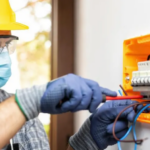Commercial Lighting Standards
 The standards for commercial lighting in the United States are primarily governed by the Department of Energy (DOE) and the Illuminating Engineering Society of North America (IESNA). These organizations establish guidelines and regulations aimed at promoting energy efficiency and providing quality lighting in commercial buildings. Following are some key standards and regulations related to commercial lighting here in the US.
The standards for commercial lighting in the United States are primarily governed by the Department of Energy (DOE) and the Illuminating Engineering Society of North America (IESNA). These organizations establish guidelines and regulations aimed at promoting energy efficiency and providing quality lighting in commercial buildings. Following are some key standards and regulations related to commercial lighting here in the US.
1. Energy Codes
The DOE has set energy codes that establish minimum requirements for energy-efficient lighting in commercial buildings. For example, the adoption of LED lighting in commercial applications is a top priority, as are the EPA ENERGY STAR requirements for such. The most widely adopted energy code is the International Energy Conservation Code (IECC), which specifies lighting power allowances, lighting controls, and other requirements for different types of spaces.
2.Lighting Efficiency Standards
The DOE also sets energy efficiency standards for various lighting products and equipment. This includes standards for lamps (such as incandescent, fluorescent, and LED lamps), luminaires (light fixtures), and lighting controls. These standards dictate the maximum allowable energy consumption and other performance criteria for lighting products.
3. Design Guidelines
The Illuminating Engineering Society of North America (IESNA) publishes Lighting Design Guidelines and Standards to ensure high-quality lighting in commercial spaces. The most widely used publication is the IES Lighting Handbook, which provides comprehensive information on lighting design practices, illuminance levels, glare control, lighting calculations, and other technical aspects.
4. Lighting Controls
Lighting control systems play a crucial role in energy management and enhancing occupant comfort. The DOE and various state energy codes require the use of lighting controls such as occupancy sensors, daylight sensors, time scheduling, and dimming capabilities to optimize energy efficiency and reduce wastage in commercial buildings.
5. ENERGY STAR
The ENERGY STAR program, administered by the Environmental Protection Agency (EPA), certifies energy-efficient lighting products that meet specific performance criteria. The program covers a wide range of commercial lighting products, including lamps, luminaires, and controls, helping consumers identify energy-saving options.
6. Voluntary Programs
Various voluntary programs and certifications exist to promote energy-efficient and sustainable lighting practices in commercial buildings. Examples include the U.S. Green Building Council’s Leadership in Energy and Environmental Design (LEED) certification, which includes lighting-related credits, and the Lighting Design Lab’s Commercial Lighting Solutions program.
7. Codes and Standards
A code is a model, a set of rules that knowledgeable people recommend for others to follow. It is not a law, but can be adopted into law. A standard tends be a more detailed elaboration, the nuts and bolts of meeting a code. Electrical and commercial lighting codes are most often subsets of state, local and national building codes.
It’s important to note that specific lighting requirements and standards can vary between states, municipalities, and building types. Local building codes and regulations may impose additional requirements or modifications to the national standards. For example, guidelines for Clark County, NV is through the adoption of the 2017 National Electrical Code With all of these codes and regulations in mind, it’s advisable to consult the relevant authorities and codes specific to your location, and any required permitting when designing or retrofitting commercial lighting systems.

Compliance with codes and standards ensures the quality, safety and energy-saving capabilities in all of your commercial lighting products. Using the highest quality in commercial grade lighting products and accessories also plays an important part, and an area that Commercial Lighting Specialties can assist you in your planning and product delivery. Please contact us…

